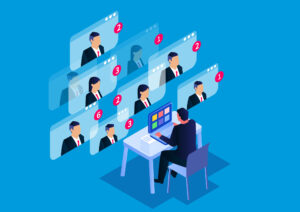How workplaces will be transformed in the wake of COVID-19
Workplace expert shares nearly 20 ways to create a safe space in your office right now for employees, as well as issues to address in the coming months.

Editor’s note: We are re-running the top stories of 2020 as part of our year-end countdown.
Much of what the next few months will bring is still unknown, but employers are beginning to consider what the return to the workplace will look like during the ongoing COVID-19 pandemic.
Though some anticipate remote working arrangements to become standard, most organizations must create a plan for employees to return to office spaces—and make changes to their form and function to keep everyone safe.
We talked to Kay Sargent, director of workplace strategy at HOK, about what organizations and communicators must consider when reinventing their workplaces in response to COVID-19.
Ragan: What are the top three concerns organizations should address as employees return to their offices in the coming months?
Sargent:
1. Assess your remote/distributed work program and modify it as needed for the coming weeks/months. Determine the role a remote/distributed work program may have going forward to offer options and choices to your workforce and how it may impact your real estate portfolio.
2. Assess the readiness of your physical environment for reentry. This may include enhancing cleaning protocols, assessing the HVAC systems, adjusting operating hours to reduce density at any given time and making modifications to existing workplace settings to address concerns regarding physical distancing and sanitization.
3. Focus on your people. Provide support for employees that may feel anxious and are dealing with the fear and uncertainty fueled by the COVID-19 crisis.
Ragan: What role should communicators play in planning their organization’s return to physical offices and re-envisioning the workplace?
Sargent: Staying connected is critical in times of crisis and separation. It’s important to provide clear and honest updates to your teams. And that extra effort is put into staying accessible and having regular check-ins with teams and colleagues.
Ragan: In what ways might workspaces be redesigned this year, without a vaccine available for COVID-19?
Sargent: The current CDC guidelines focus on cleanliness, physical distancing, wearing personal protective equipment and reducing touch points. But it’s important to note that none of these offer any assurance and none by themselves are a holistic approach. There are a variety of common sense best practices that you should consider when you determine it’s time to reenter the workplace:
- Expand spacing between seats at work points to a minimum of 6’ and/or reorient work points so individuals do not directly face each other.
- Provide disposable desk pads for individuals to use at work points and in meetings.
- Create clean desk policies that allow surfaces to be properly cleaned daily and update facility maintenance contracts to ensure these steps are taken.
- Ensure passageways enable generosity of spacing and enact circular routing within the space for safe passage within the space. Eliminate accidental contact at blind corners.
- For spaces with multiple doors, separate entry and exiting where possible.
- Remove seats at communal tables and in conference rooms to give people additional personal space. Leverage stools to encourage standing meetings and distancing.
- Leverage sensor tech tied to a booking system to block out seating to ensure spacing, identify available work points, monitor office density, block spaces that have been used and not yet cleaned, and drive cleaning based on use.
- Introduce automation, voice activation or hands-free controls that limit the need to touch commonly used items and reduce exposure to germs. Leverage stylus to eliminate the need to touch buttons and screen.
- Switch to VOIP communication technology instead of phone handsets and eliminate shared keyboard trays.
- Assign lockers, file drawers or storage cabinets to individuals to store personal items. Leverage electronic, hands-free locking mechanisms.
- Reduce storage at shared work points so there is less to clean/sanitize.
- Remove trash cans and recycle bins from individual work points and replace them with communal repositories in a communal location to consolidate sanitation and exposure.
- Work with building management to improve air circulation, filtration and ventilation.
- Increase hand washing opportunities outside of restrooms and introduce sanitation stations in copy areas and breakout spaces.
- Review FFE (furniture, fixtures and equipment) and material specifications to include anti-microbial treatments and bleach cleanable.
- Reduce absorbent material that trap germs and toxins in the space and reassess the potential impact on acoustics in the space.
- Review FFE standards, kit-of-parts and design guidelines for durability, cleanability and lifecycle cost.
- Install hard surface dividers between work points to help define work points and add dividers, such as mobile markerboards, screens, planters, lockers or cabinets within the open space to increase shielding.
Ragan: What lasting changes can we expect to see in the way workspaces are designed?
Sargent: The office will likely be changed forever going forward. Everyone now has a heightened sensitivity about cleanliness, touch and proximity. People are also more informed and will be seeking spaces that help address not only this pandemic, but other health concerns. But we don’t know what we don’t know. We need to continually assess and adjust to determine the right path forward.
Ragan: Will the purpose and significance of office spaces endure, or will their function and importance change if remote work becomes more popular?
Sargent: Companies and the workforce will likely be looking for more options and choices, hence we may see a more blended model in the future. Going forward we will likely see remote/distributed work program be expanded and be part of the work ecosystem. More and more heads-down, concentrative work may happen outside the “office.” And what was defined as the “office” may evolve to be more of a gathering space designed for collaboration and connectivity.







